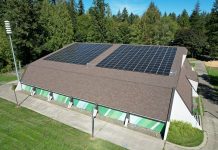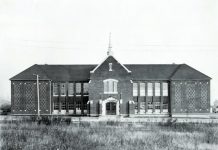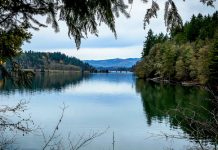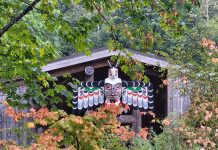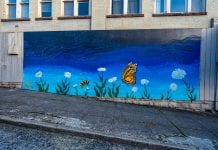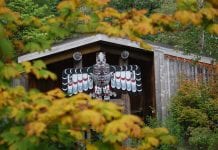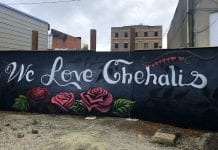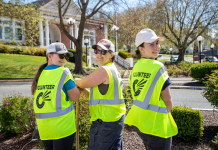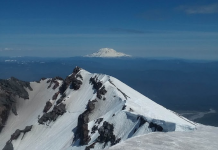Our East Lewis County mountains bless us with abundant places to play in the snow. Sledding hills lie a short distance up many forest service roads. Sno-parks provide miles of snowmobile routes and dozens of cross-country ski and snowshoe trails. That jewel of the South Cascades, White Pass Ski Area, offers adventures for every sort of snow rider.
Still, climate change, or just the routine Pineapple Express, sometimes brings low snow or rain to the mountains. If low snow means no-go to your favorite snowy haunts, take heart! These rain-proof alternatives will please everyone in the family. All have a roof to protect you from the storm.
First up, take the White Pass Scenic Byway to Mary’s Corner. Turn south and go a scant 500 feet on the Jackson Highway to find the Jackson House Heritage Site. The recently restored cabin is the site to the 1850 homestead of John and Matilda Jackson, important figures in early Washington territorial history. Buildings on the homestead served as a post office, grocery store, hotel, tavern, and a U.S District Court. The site was a stopping place on the Cowlitz Trail, an extension of the Oregon Trail which took pioneers from Oregon City to Seattle. Arrange tours in advance by calling Washington State Parks at the phone number on the website. The cabin has a roof, of course.
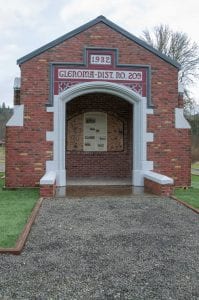
Head back to the White Pass Scenic Byway, cross over, and continue north on the Jackson Highway a third of a mile to find Matilda N. Jackson State Park. Here you’ll find a monument to the Cowlitz Trail extension of the Oregon Trail, placed by the Daughters of the American Revolution. There’s a bathroom here if you need it and a picnic shelter, which provides the roof.
Return to the White Pass Scenic Byway and go east. Pass Morton (we’ll stop on the return trip), then continue to Glenoma. Shortly after Meade Hill Road and milepost 106, you’ll see a Heritage Site marker pointing right. Turn into the driveway where you see the brick and stone monument to “1932 Glenoma-Dist. No. 209.” You’ll find parking behind the monument, and picnic tables adjacent.
The monument commemorates Glenoma Elementary School, which served the community for 70 years. Glenoma district teachers and staff built the monument with materials from the school. Inside there’s room for a half dozen people to stand. Look up to see the brilliant tin roof from the original school, gloriously preserved.

Returning to the White Pass Scenic Byway, continue east. If hungry, consider stopping a mile and a half before you enter Randle at the Huff-and-Puff Drive-In, which you’ll recognize by the giant EAT sign. They offer excellent drive-in or dine-in food, including an elk burger and a deliciously sinful 32-ounce milkshake.
The Huff-and-Puff suffered a fire that closed the establishment for long while. The Randle community rallied, holding several fundraising events to help the business recover. Labor Day in 2018 it reopened to the delight of many loyal customers.
During the fire rebuild, Huff-and-Puff added ample new dining space, which is very kid-friendly.

Layser Cave, one of the state’s most significant archaeological sites, is the next destination. From Randle, turn right on Highway 131, drive one mile and turn left onto Cispus Road FS-23. Drive about seven miles and turn left onto the Layser Cave Road FS-038. The parking area and trailhead are on a sharp left turn in the road. For a map of this route, click here.
The cave is a quarter-mile walk from the parking area. Interpretive signs along the trail explain how early people hunted and used the cave. The cave opens into a large room with a sandy floor. The cave goes back a ways then pinches down to the sand. It’s safe to explore.
Outside near the cave is an overlook where you may see a vast stretch of the Cispus River valley and imagine being a member of a hunting party 7,000 years ago. The roof here – the cave’s prehistoric rock.
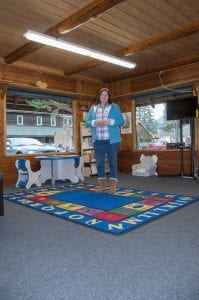
Back on White Pass Scenic Byway, continue east to Packwood and the next destination: Packwood Timberland Library. Packwood’s library lives in a strikingly beautiful log building gifted to the library system by the Combs family. Sherman Combs completed the building in 1958. There’s a painting of him in the library, painted by artist Irene Anderson.
Before becoming a library, the building housed the Packwood Post Office, a rock shop, an antique store, and a museum. Library Manager Elizabeth Squires notes, “There are 27 species of wood in the building, which come from private land or the local forest.”
The library features a generous children’s room and offers many activities for kids to do on a rainy day: Wii and board games, coloring sheets, computers and, of course, books.
One recent Saturday, rain afflicted the ski slopes and White Pass Ski Area closed early due to high winds. Erstwhile skiers sought refuge among Packwood’s attractions. The library’s children’s room buzzed with families reading to their children, playing games, using the computers, or just sprawling on the large alphabet rug. Visit during a rainy day when the kids are looking for something do, or just to enjoy the sturdy metal roof over the gorgeous log walls.
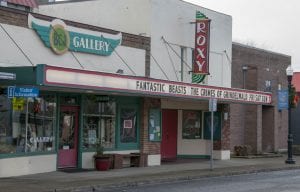
By this time, daylight may be growing short. Before returning home, an evening’s entertainment awaits back on the White Pass Scenic Byway in Morton. The renovated 1937 Roxy Theatre shows first-run movies on weekends and frequently produces live performances. The Fire Mountain Arts Council, which owns and operates the theater, also fosters local art and provides art education for youth. And they fixed the roof over the stage, too.
After this journey, the rains in the mountains should have passed (hopefully) and blessed snow returned. But remember these places when spring and summer arrive, and consider visiting them again – although the roofs may be no longer necessary.





